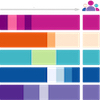
| | |
Sharon Zhou, Melissa Valentine, Michael S. Bernstein
| |
CHI: ACM Conference on Human Factors in Computing Systems, 2018
|
|
Team structures---roles, norms, and interaction patterns---define how teams work. HCI researchers have theorized ideal team structures and built systems nudging teams towards them, such as those increasing turn-taking, deliberation, and knowledge distribution. However, organizational behavior research argues against the existence of universally ideal structures. Teams are diverse and excel under different structures: while one team might flourish under hierarchical leadership and a critical culture, another will flounder. In this paper, we present DreamTeam: a system that explores a large space of possible team structures to identify effective structures for each team based on observable feedback. To avoid overwhelming teams with too many changes, DreamTeam introduces multi-armed bandits with temporal constraints: an algorithm that manages the timing of exploration--exploitation trade-offs across multiple bandits simultaneously. A field experiment demonstrated that DreamTeam teams outperformed self-managing teams by 38%, manager-led teams by 46%, and teams with unconstrained bandits by 41%. This research advances computation as a powerful partner in establishing effective teamwork.
|
|
|
This project is known for:
collaborative computing; teams; technical social computing; multi-armed bandits